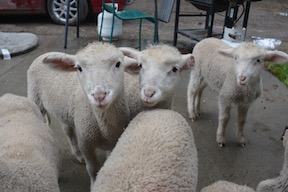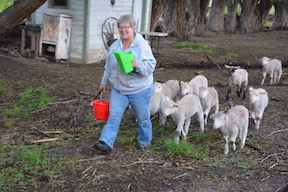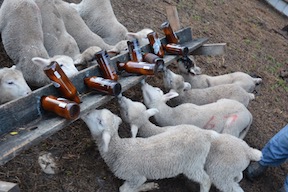With the sheep
25/05/15 05:00
Our bible reflects a certain slice of the story of our people. Although there are several places, including Psalms and the opening stories of the book of Genesis, where the Bible looks back at the beginnings and origins, for the most part, the story begins with Abraham and Sarah and their journey away from the land of their parents and grandparents. It continues through many different generations of our people and tells of the places where our people lived and died and the generations of of Israel from freedom to slavery to freedom to the establishment of the monarchy to glory in the days of Solomon to the fall and eventual exile and the words of the prophets.
Similarly the New Testament tells the story of Jesus and continues through the early generations of the Christian Church. After the books that are in our Bible were in their completed forms, it took quite a while for the church to settle on the exact configuration of the Bible. Other books existed that weren’t deemed to be biblical and, as is true with all family stories, there were some gaps where the stories had been lost or forgotten.
After the bible was set in a form close to what we now know, it was used by our people for many generations - in worship, in private study, and for teaching language, culture, history and theology.
 For the most part, the bible chronicles a time in our people’s lives when we were rural - often nomadic - and lived close to the land. From the beginnings of the stories in our Bible to the days then the letters of Paul were written, we shared our journey with animals. Most of the time our people kept a few sheep and goats and other livestock raised for milk and meat. Agricultural images were important ways of communicating the stories of our people and animals were often part of the metaphors that were used to point to larger truths. This was because animals were something that our people knew.
For the most part, the bible chronicles a time in our people’s lives when we were rural - often nomadic - and lived close to the land. From the beginnings of the stories in our Bible to the days then the letters of Paul were written, we shared our journey with animals. Most of the time our people kept a few sheep and goats and other livestock raised for milk and meat. Agricultural images were important ways of communicating the stories of our people and animals were often part of the metaphors that were used to point to larger truths. This was because animals were something that our people knew.
These days, when we recite “The Lord is my Shepherd,” not many of us know that image in the same way that our forebears did. I’ve never raised sheep. My children didn’t have livestock in the yard during their growing-up years. The animals that we eat for food were raised by others and, for the most part, were obtained by us as packaged meat in the supermarket - well removed from the processes of its growing.
So it is good for me to visit the ranch from time to time. In my growing up and teenage years, when I spoke of the ranch, I was usually thinking of the place along the Missouri River between Carter and Floweree, Montana, where my Uncle and Cousin farmed the homestead of my mother’s parents and grandparents. It was mostly a dry land wheat operation, with a few chickens and a milk cow thrown in from time to time. Then, as my cousin acquired more of the river break land, the operation expanded to beef cattle. These days, I often refer to the Duck Creek ranch where my sister lives, which is a mixed cattle and sheep operation with a few hunters and dudes tossed in for good measure.
 My sister raises bum lambs. This year I think there are ten of them. Orphaned near their births, the lambs have to learn to be fed by humans. She starts them out with a powdered milk formula in beer bottles and as they grow the bottles have to get bigger to hold enough for the lambs and they begin to eat grain and before long they can be turned out to the fresh green spring grass in the pasture. The lambs are about a month old now. They’re used to the bottles and when she puts them out, the lambs rush in and eat as quickly as they can. The bottles are emptied in just a few minutes. It takes longer to prepare the formula and wash the bottles than it does to feed the sheep.
My sister raises bum lambs. This year I think there are ten of them. Orphaned near their births, the lambs have to learn to be fed by humans. She starts them out with a powdered milk formula in beer bottles and as they grow the bottles have to get bigger to hold enough for the lambs and they begin to eat grain and before long they can be turned out to the fresh green spring grass in the pasture. The lambs are about a month old now. They’re used to the bottles and when she puts them out, the lambs rush in and eat as quickly as they can. The bottles are emptied in just a few minutes. It takes longer to prepare the formula and wash the bottles than it does to feed the sheep.
The lambs follow her around whenever she goes out into the yard. They know the source of their meals. And, when they are hungry they bleat and cry and fuss. At this age they are small enough for her to pick them up and sort them out when they get mixed up or when a bully tries to steal another’s bottle.
It won’t be long before the lambs don’t need the bottles any more. They’ll be weaned and will be able to forage for their own food in the pastures. The other lambs on the ranch have already been moved, with their mothers, to summer pasture. Before winter returns to the high country the lambs will have been sold and the cycle begins again. There will be new lambs next spring and some of them will need to be bottle fed and raised close to the house.
 It is a very different enterprise than what I do for a living. My job title, pastor, has agricultural roots and pastors are often referred to as shepherds and our congregations as our flocks, but the analogy that seemed so appropriate in the days when virtually all of our people had a few head of sheep. The title was acquired by ministers when everyone knew that sheep come and sheep go and that the flock, while carrying the genetic strain of its heritage, is constantly changing with some animals becoming dinner, some being bred for next year’s young and a constant process of turnover. It was assumed that every shepherd was constantly welcoming new birth, nurturing weak or injured animals, but also culling the herd and looking to the long term life of the group to provide individuals for food for the people.
It is a very different enterprise than what I do for a living. My job title, pastor, has agricultural roots and pastors are often referred to as shepherds and our congregations as our flocks, but the analogy that seemed so appropriate in the days when virtually all of our people had a few head of sheep. The title was acquired by ministers when everyone knew that sheep come and sheep go and that the flock, while carrying the genetic strain of its heritage, is constantly changing with some animals becoming dinner, some being bred for next year’s young and a constant process of turnover. It was assumed that every shepherd was constantly welcoming new birth, nurturing weak or injured animals, but also culling the herd and looking to the long term life of the group to provide individuals for food for the people.
We don’t think of our churches that way these days. We long for a sense of stability. We want guarantees about the future. We wonder about funding and finances and institutional maintenance in a manner that is very different from raising sheep. We hold capital funds drives and talk about cash flow and energy management and volunteer coordination.
And so, every once in a while, I head to the ranch and help with the sheep and remind myself that it is all a matter of perspective.
Similarly the New Testament tells the story of Jesus and continues through the early generations of the Christian Church. After the books that are in our Bible were in their completed forms, it took quite a while for the church to settle on the exact configuration of the Bible. Other books existed that weren’t deemed to be biblical and, as is true with all family stories, there were some gaps where the stories had been lost or forgotten.
After the bible was set in a form close to what we now know, it was used by our people for many generations - in worship, in private study, and for teaching language, culture, history and theology.

These days, when we recite “The Lord is my Shepherd,” not many of us know that image in the same way that our forebears did. I’ve never raised sheep. My children didn’t have livestock in the yard during their growing-up years. The animals that we eat for food were raised by others and, for the most part, were obtained by us as packaged meat in the supermarket - well removed from the processes of its growing.
So it is good for me to visit the ranch from time to time. In my growing up and teenage years, when I spoke of the ranch, I was usually thinking of the place along the Missouri River between Carter and Floweree, Montana, where my Uncle and Cousin farmed the homestead of my mother’s parents and grandparents. It was mostly a dry land wheat operation, with a few chickens and a milk cow thrown in from time to time. Then, as my cousin acquired more of the river break land, the operation expanded to beef cattle. These days, I often refer to the Duck Creek ranch where my sister lives, which is a mixed cattle and sheep operation with a few hunters and dudes tossed in for good measure.

The lambs follow her around whenever she goes out into the yard. They know the source of their meals. And, when they are hungry they bleat and cry and fuss. At this age they are small enough for her to pick them up and sort them out when they get mixed up or when a bully tries to steal another’s bottle.
It won’t be long before the lambs don’t need the bottles any more. They’ll be weaned and will be able to forage for their own food in the pastures. The other lambs on the ranch have already been moved, with their mothers, to summer pasture. Before winter returns to the high country the lambs will have been sold and the cycle begins again. There will be new lambs next spring and some of them will need to be bottle fed and raised close to the house.

We don’t think of our churches that way these days. We long for a sense of stability. We want guarantees about the future. We wonder about funding and finances and institutional maintenance in a manner that is very different from raising sheep. We hold capital funds drives and talk about cash flow and energy management and volunteer coordination.
And so, every once in a while, I head to the ranch and help with the sheep and remind myself that it is all a matter of perspective.